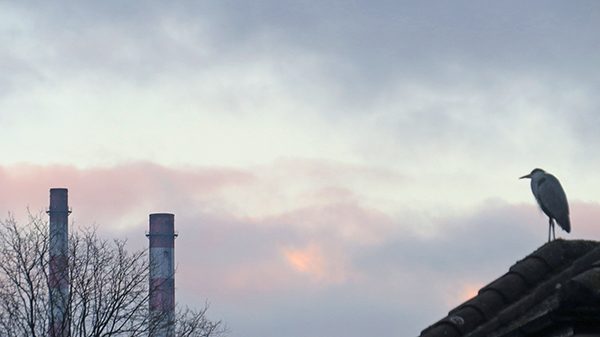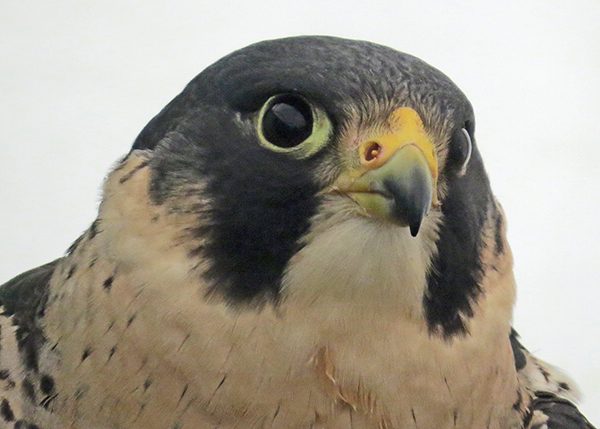
Above: Birdlife in the shadow of the Poolbeg Power Station.
The stretch of Dublin bay covering both the North and South Bull has been deemed to be an area of particular importance as a UNESCO Biosphere reserve. This of course punches above its weight and is in the same league as many natural wonders and exotic destinations.
At first glance on a cold windswept day one may dismiss the sight of the heaths, the sheer windswept stretch of coast beside the semi-derelict Poolbeg Power station, the old Poolbeg army barracks and the Victorian russet brown factory, lying vacant amid the long grass as these remain to be monuments to an old Dublin, with the old industries and trade that existed at the time and which have become embedded in the silence of history.
But there is more than meets the eye upon first glance. Wildlife is living and thriving here, where certain species are adapting to man-made structures available when natural habitats may be unavailable. The adaptability of certain bird species is incredible. Certain birds are making a comeback and offering the people of Dublin the opportunity to view some beautiful birds of the Irishtown wilderness.
NewsFour caught up with local wildlife expert and film producer, Eamonn Ryan, on an update of the Peregrine Falcon pair, at the stacks of the old Poolbeg power station, where the female is currently incubating the eggs for the chicks which will be born soon.
On a sunny, clear blue-skied afternoon, Ryan pointed out with a telescopic lens the male peregrine falcon standing on duty, guarding the female during her pregnancy.
“When the chicks hatch, the male will become much more aggressive and protective of the young. If he sees a seagull or a magpie he will go for it, he’ll even fight off a kestrel if it strays too close to their territory.”

Above: Peregrine falcon.
“I do believe that peregrine numbers have increased to 600 pairs nationwide which is wonderful and so they are expanding to tall, man-made structures where the habitat is unavailable. But people still, even locally, threaten the birds, especially those who keep pigeon lofts.”
On that warm but crisp day, the sight of a snowy white little egret soared above, linnets fluttered by the heaths and a red admiral butterfly made a brave, early appearance in this time of unpredictable weather.
This area has been known to have other fine birds such as the Eurasian sparrowhawk, barn owl, buzzard, curlew and kestrel.
In the winter months, short-eared owls have been recorded circling over the heath, along with such obscure beauties as the merlin falcon which has been counted too.
The summer months bring the return of many bird migrants, where swallows, common swifts, sand martins and house martins return in large numbers to grace our summer skies. This, of course, is the time of year from June to July, to see the harbour porpoise, whose numbers acquaint the coves and inlets of Dublin’s bay and coastline.
This is a time where life returns in abundance, where creatures come to breed and prepare for the next generation.
Around the original but derelict ESB power station, Ryan pointed out where the resident kestrels were nesting. It is impressive to see the terracotta brown plumage of the kestrel hover above in search of prey against the backdrop of the sun! “Kestrels have to be careful that their nest is not raided by magpies and seagulls, as they are not as big and strong as the peregrine falcons,” he noted.
Halfway between the South Bull Peninsula and Dollymount Strand, you can see a pontoon, a man-made construct for the use of Arctic terns that have already bred there in the past, numbering at least two dozen. As terns have been known to frequent Dublin bay over the past 50 years, the Dublin Port Company, has actively been working to encourage and to create an environment for different migratory tern species that return to Ireland during the summer months. This project is being run by Dublin Port, under the supervision of environmentalist Richard Nairn.
The pontoon has been framed with timber panels, and covered in shingle to emulate the natural habitat of an undisturbed beach environment for the terns. All this is to minimise any risks from both land dwelling and aquatic predators and create a rough and uneven surface for the covering of tern eggs, camouflage is essential for the survival and perfect habitat of the tern colony.
Despite all the encouraging efforts made by local authorities and the wildlife experts, like Birdwatch Ireland, pollution, waste management and poisoning are issues that need to be properly addressed.
Legislation needs to be put in force for the full effect of protection, given to the local ecology.
“Barn owls get hit hard with secondary poisoning, the ongoing rat control poison schemes which tend to be in place around the docks and sewage treatment areas mean there are wobbly dying rodents around that the owls make a meal of. The poison builds up in their own system that way. Barn owls are also fond of hunting on grass verges along roadsides and train verges, so they get hit by vehicles a lot. I’m afraid these days I don’t see them around the area,” said Ryan.
This is an ongoing process and development. These man-made schemes are encouraging signs for this environment deemed to be a “UNESCO Biosphere Reserve.”
By Robert Fullarton

